Snow Cover Response to Climatological Factors at the Beas River Basin of W. Himalayas from MODIS and ERA5 Datasets
Abstract
:1. Introduction
2. Materials and Methods
2.1. Study Area
2.2. Dataset
2.2.1. Modis Product
2.2.2. ASTER DEM
2.2.3. Precipitation and Temperature Data
2.3. Methodology
2.3.1. Seasonal Filtering
2.3.2. Temporal Filtering
2.3.3. Spatial Filtering
2.3.4. Combining Snow Products (Filtered Terra and Aqua Images)
2.3.5. Combined Glaciers (RGI 6.0) in the Improved Snow Product
2.4. Statistical Analysis
3. Results and Discussion
3.1. Variation of SCA Annually
3.2. Seasonal Variation of SCA
3.3. Relation between Elevation and SCA
3.4. Relation between SCA and Slope
3.5. Relation between Aspect and SCA
3.6. Relation between Climate Data and SCA
4. Conclusions
Author Contributions
Funding
Institutional Review Board Statement
Informed Consent Statement
Data Availability Statement
Acknowledgments
Conflicts of Interest
References
- Immerzeel, W.W.; Van Beek, L.P.H.; Bierkens, M.F.P. Climate change will affect the asian water towers. Science 1979, 328, 1382–1385. [Google Scholar] [CrossRef]
- Rixen, C.; Teich, M.; Lardelli, C.; Gallati, D.; Pohl, M.; Pütz, M.; Bebi, P. Winter tourism and climate change in the Alps: An assessment of resource consumption, snow reliability, and future snowmaking potential. Mt. Res. Dev. 2011, 31, 229–236. [Google Scholar] [CrossRef]
- Sharma, V.; Mishra, V.D.; Joshi, P.K. Snow cover variation and streamflow simulation in a snow-fed river basin of the Northwest Himalaya. J. Mt. Sci. 2012, 9, 853–868. [Google Scholar] [CrossRef]
- Barman, S.; Bhattacharjya, R.K. Change in snow cover area of Brahmaputra River basin and its sensitivity to temperature. Environ. Syst. Res. 2015, 4, 16. [Google Scholar] [CrossRef]
- Farinotti, D.; Usselmann, S.; Huss, M.; Bauder, A.; Funk, M. Runoff evolution in the Swiss Alps: Projections for selected high-alpine catchments based on ENSEMBLES scenarios. Hydrol. Process. 2012, 26, 1909–1924. [Google Scholar] [CrossRef]
- Wipf, S.; Stoeckli, V.; Bebi, P. Winter climate change in alpine tundra: Plant responses to changes in snow depth and snowmelt timing. Clim. Chang. 2009, 94, 105–121. [Google Scholar] [CrossRef]
- Bühler, Y.; Marty, M.; Egli, L.; Veitinger, J.; Jonas, T.; Thee, P.; Ginzler, C. Snow depth mapping in high-alpine catchments using digital photogrammetry. Cryosphere 2015, 9, 229–243. [Google Scholar] [CrossRef]
- Kulkarni, A.V.; Bahuguna, I.M.; Singh, S.K. Glacial Retreat in Himalayas Using Indian Remote Sensing Satellite Data. Available online: https://www.researchgate.net/publication/260673054 (accessed on 27 August 2023).
- Negi, H.S.; Shekhar, M.S.; Gusain, H.S.; Ganju, A. Winter climate and snow cover variability Over North-West Himalaya. In Science and Geopolitics of the White World: Arctic-Antarctic-Himalaya; Taylor and Francis Inc.: Abingdon, UK, 2017; pp. 127–142. [Google Scholar]
- Gurung, D.R.; Maharjan, S.B.; Shrestha, A.B.; Shrestha, M.S.; Bajracharya, S.R.; Murthy, M.S.R. Climate and topographic controls on snow cover dynamics in the Hindu Kush Himalaya. Int. J. Climatol. 2017, 37, 3873–3882. [Google Scholar] [CrossRef]
- Report, F.; Environment, M.O.F.; Change, C. Cumulative Impact & Carrying Capacity Study (CIA & CCS) of Beas Sub Basin in Himachal Pradesh; Prepared for Ministry of Environment, Forest and Climate Change Government of India; R.S Envirolink Technologies Pvt. Ltd.: Gurugram, India, 2019. [Google Scholar]
- Sahu, R.; Gupta, R.D. Snow Cover Analysis in Chandra Basin of Western Himalaya from 2001 to 2016. In Applications of Geomatics in Civil Engineering; Lecture Notes in Civil Engineering; Springer: Berlin/Heidelberg, Germany, 2020; pp. 557–566. [Google Scholar]
- Shiklomanov, I.A.; Rodda, J.C. World Water Resources at the Beginning of the Twenty-First Century; Cambridge University Press: Cambridge, UK, 2003; 435p. [Google Scholar]
- Bousbaa, M.; Htitiou, A.; Boudhar, A.; Eljabiri, Y.; Elyoussfi, H.; Bouamri, H.; Ouatiki, H.; Chehbouni, A. High-Resolution Monitoring of the Snow Cover on the Moroccan Atlas through the Spatio-Temporal Fusion of Landsat and Sentinel-2 Images. Remote Sens. 2022, 14, 5814. [Google Scholar] [CrossRef]
- Notarnicola, C. Hotspots of snow cover changes in global mountain regions over 2000–2018. Remote Sens. Environ. 2020, 243, 111781. [Google Scholar] [CrossRef]
- Wang, Q.; Ma, Y.; Li, J. Snow Cover Phenology in Xinjiang Based on a Novel Method and MOD10A1 Data. Remote Sens. 2023, 15, 1474. [Google Scholar] [CrossRef]
- Kumar, P.; Saharwardi, M.S.; Banerjee, A.; Azam, M.F.; Dubey, A.K.; Murtugudde, R. Snowfall Variability Dictates Glacier Mass Balance Variability in Himalaya-Karakoram. Sci. Rep. 2019, 9, 18192. [Google Scholar] [CrossRef]
- Zhao, Q.; Liu, Z.; Li, M.; Wei, Z.; Fang, S. The Snowmelt Runoff Forecasting Model of Coupling WRF and DHSVM. Hydrol. Earth Syst. Sci. Discuss. 2009, 13, 1897–1906. Available online: https://www.hydrol-earth-syst-sci-discuss.net/6/3335/2009/ (accessed on 15 October 2009). [CrossRef]
- Ji, H.; Peng, D.; Gu, Y.; Luo, X.; Pang, B.; Zhu, Z. Snowmelt Runoff in the Yarlung Zangbo River Basin and Runoff Change in the Future. Remote Sens. 2023, 15, 55. [Google Scholar] [CrossRef]
- Sharma, V.; Mishra, V.D.; Joshi, P.K. Topographic controls on spatio-temporal snow cover distribution in Northwest Himalaya. Int. J. Remote Sens. 2014, 35, 3036–3056. [Google Scholar] [CrossRef]
- Nagajothi, V.; Priya, M.G.; Sharma, P. Snow Cover Estimation of Western Himalayas using Sentinel-2 High Spatial Snow Cover Estimation of Western Himalayas using Sentinel-2 High Spatial Resolution Data. Indian J. Ecol. 2019, 46, 88–93. [Google Scholar]
- Dai, L.; Che, T.; Ding, Y.; Hao, X. Evaluation of snow cover and snow depth on the Qinghai-Tibetan Plateau derived from passive microwave remote sensing. Cryosphere 2017, 11, 1933–1948. [Google Scholar] [CrossRef]
- McClung, D.M. Avalanche character and fatalities in the high mountains of Asia. Ann. Glaciol. 2016, 57, 114–118. [Google Scholar] [CrossRef]
- Brown, R.D. Northern Hemisphere Snow Cover Variability and Change, 1915–1997. J. Clim. 2000, 13, 2339–2355. [Google Scholar] [CrossRef]
- Frei, A.; Robinson, D. Northern hemisphere snow extent: Regional variability 1972–1994. Int. J. Climatol. 1999, 19, 1525–1560. [Google Scholar] [CrossRef]
- Salomonson, V.V.; Appel, I. Estimating fractional snow cover from MODIS using the normalized difference snow index. Remote Sens. Environ. 2004, 89, 351–360. [Google Scholar] [CrossRef]
- Gurung, D.R.; Kulkarni, A.V.; Giriraj, A.; Aung, K.S.; Shrestha, B.; Srinivasan, J. Article in Changes in Seasonal Snow Cover in Hindu Kush-Himalayan Region. Cryosphere Discuss. 2011, 5, 755–777. Available online: https://www.the-cryosphere-discuss.net/5/755/2011/ (accessed on 27 August 2023).
- Sood, V.; Gusain, H.S.; Gupta, S.; Taloor, A.K.; Singh, S. Detection of snow/ice cover changes using subpixel-based change detection approach over Chhota-Shigri glacier, Western Himalaya, India. Quat. Int. 2021, 575–576, 204–212. [Google Scholar] [CrossRef]
- Rathore, B.P.; Bahuguna, I.M.; Singh, S.K.; Brahmbhatt, R.M.; Randhawa, S.S.; Jani, P.; Yadav, S.K.S.; Rajawat, A.S. Trends of snow cover in Western and West-Central Himalayas during 2004–2014. Curr. Sci. 2018, 114, 800–807. [Google Scholar] [CrossRef]
- Gusain, H.S.; Mishra, V.D.; Arora, M.K.; Mamgain, S.; Singh, D.K. Operational algorithm for generation of snow depth maps from discrete data in Indian Western Himalaya. Cold Reg. Sci. Technol. 2016, 126, 22–29. [Google Scholar] [CrossRef]
- Taloor, A.K.; Ray, P.K.C.; Jasrotia, A.S.; Kotlia, B.S.; Alam, A.; Kumar, S.G.; Kumar, R.; Kumar, V.; Roy, S. Active tectonic deformation along reactivated faults in Binta basin in Kumaun Himalaya of north India: Inferences from tectono-geomorphic evaluation. Z. Geomorphol. 2017, 61, 159–180. [Google Scholar] [CrossRef]
- Singh, S.; Sood, V.; Taloor, A.K.; Prashar, S.; Kaur, R. Qualitative and quantitative analysis of topographically derived CVA algorithms using MODIS and Landsat-8 data over Western Himalayas, India. Quat. Int. 2021, 575–576, 85–95. [Google Scholar] [CrossRef]
- Yan, W.; Wang, Y.; Ma, X.; Liu, M.; Yan, J.; Tan, Y.; Liu, S. Snow Cover and Climate Change and Their Coupling Effects on Runoff in the Keriya River Basin during 2001–2020. Remote Sens. 2023, 15, 3435. [Google Scholar] [CrossRef]
- Minghua, L.; Jinmeng, M.; Liming, W.; Shan, L.; Junhui, Y.; Jinke, L.; Zhonghua, H.; Yue, C. Spatial and temporal variations of shallow ground temperature in the Huaihe River source and its response to recent global warming hiatus. J. Xinyang Norm. Univ. 2023, 36, 180–185. [Google Scholar]
- Singh, D.K.; Mishra, V.D.; Gusain, H.S.; Singh, K.K.; Das, R.K.; Gupta, N. Validation of Landsat-8 satellite-derived radiative energy fluxes using wireless sensor network data over Beas River basin, India. Int. J. Remote Sens. 2021, 42, 6891–6918. [Google Scholar] [CrossRef]
- Desinayak, N.; Prasad, A.K.; El-Askary, H.; Kafatos, M.; Asrar, G.R. Snow cover variability and trend over Hindu Kush Himalayan region using MODIS and SRTM data. Ann. Geophys. 2022, 40, 67–82. [Google Scholar] [CrossRef]
- Sood, V.; Singh, S.; Taloor, A.K.; Prashar, S.; Kaur, R. Monitoring and mapping of snow cover variability using topographically derived NDSI model over north Indian Himalayas during the period 2008–2019. Appl. Comput. Geosci. 2020, 8, 100040. [Google Scholar] [CrossRef]
- Singh, V.P.; Singh Umesh Haritashya, P.K. Encyclopedia of Snow, Ice and Glaciers; Springer Science & Business Media: Dordrecht, The Netherlands, 2011; Available online: https://ecommons.udayton.edu/geo_fac_pub/7/ (accessed on 29 June 2011).
- Huang, X.; Deng, J.; Wang, W.; Feng, Q.; Liang, T. Impact of climate and elevation on snow cover using integrated remote sensing snow products in Tibetan Plateau. Remote Sens. Environ. 2017, 190, 274–288. [Google Scholar] [CrossRef]
- Liang, T.G.; Huang, X.D.; Wu, C.X.; Liu, X.Y.; Li, W.L.; Guo, Z.G.; Ren, J.Z. An application of MODIS data to snow cover monitoring in a pastoral area: A case study in Northern Xinjiang, China. Remote Sens. Environ. 2008, 112, 1514–1526. [Google Scholar] [CrossRef]
- Tahir, A.A.; Chevallier, P.; Arnaud, Y.; Ashraf, M.; Bhatti, M.T. Snow cover trend and hydrological characteristics of the Astore River basin (Western Himalayas) and its comparison to the Hunza basin (Karakoram region). Sci. Total Environ. 2015, 505, 748–761. [Google Scholar] [CrossRef]
- Shafiq, M.U.; Ahmed, P.; Islam, Z.U.; Joshi, P.K.; Bhat, W.A. Snow cover area change and its relations with climatic variability in Kashmir Himalayas, India. Geocarto Int. 2019, 34, 688–702. [Google Scholar] [CrossRef]
- Hu, J.M.; Shean, D. Improving Mountain Snow and Land Cover Mapping Using Very-High-Resolution (VHR) Optical Satellite Images and Random Forest Machine Learning Models. Remote Sens. 2022, 14, 4227. [Google Scholar] [CrossRef]
- Muhammad, S.; Thapa, A. An improved Terra/Aqua MODIS Snow-Cover and RGI6.0 Glacier Combined Product (MOYDGL06*) for the High Mountain Asia between 2002 and 2018. Earth Syst. Sci. Data 2020, 12, 345–356. [Google Scholar] [CrossRef]
- Zhang, T.; Wooster, M.J.; Xu, W. Approaches for synergistically exploiting VIIRS I- and M-Band data in regional active fire detection and FRP assessment: A demonstration with respect to agricultural residue burning in Eastern China. Remote Sens. Environ. 2017, 198, 407–424. [Google Scholar] [CrossRef]
- Gao, Y.; Xie, H.; Yao, T.; Xue, C. Integrated assessment on multi-temporal and multi-sensor combinations for reducing cloud obscuration of MODIS snow cover products of the Pacific Northwest USA. Remote Sens. Environ. 2010, 114, 1662–1675. [Google Scholar] [CrossRef]
- Hüsler, F.; Jonas, T.; Riffler, M.; Musial, J.P.; Wunderle, S. A satellite-based snow cover climatology (1985–2011) for the European Alps derived from AVHRR data. Cryosphere 2014, 8, 73–90. [Google Scholar] [CrossRef]
- Mann, H.B. Nonparametric Tests against Trend1. Econometrica 1945, 13, 245–259. [Google Scholar] [CrossRef]
- Kendall, S.B. Enhancement of Conditioned Reinforcement by Uncertainty 1. J. Exp. Anal. Behav. 1975, 24, 311–314. [Google Scholar] [CrossRef]
- Kumar Sen, P. Estimates of the Regression Coefficient Based on Kendall’s Tau. J. Am. Stat. Assoc. 1968, 63, 1379–1389. [Google Scholar]
- Jain, S.K.; Goswami, A.; Saraf, A.K. Accuracy assessment of MODIS, NOAA and IRS data in snow cover mapping under Himalayan conditions. Int. J. Remote Sens. 2008, 29, 5863–5878. [Google Scholar] [CrossRef]
- Kour, R.; Patel, N.; Krishna, A.P. Effects of terrain attributes on snow-cover dynamics in parts of Chenab basin, western Himalayas. Hydrol. Sci. J. 2016, 61, 1861–1876. [Google Scholar] [CrossRef]
- Sharma, S.S.; Ganju, A. Complexities of Avalanche Forecasting in Western Himalaya—An Overview. Cold Reg. Sci. Technol. 2000, 31, 95–102. Available online: http://www.elsevier.comrlocatercoldregions (accessed on 27 August 2023). [CrossRef]

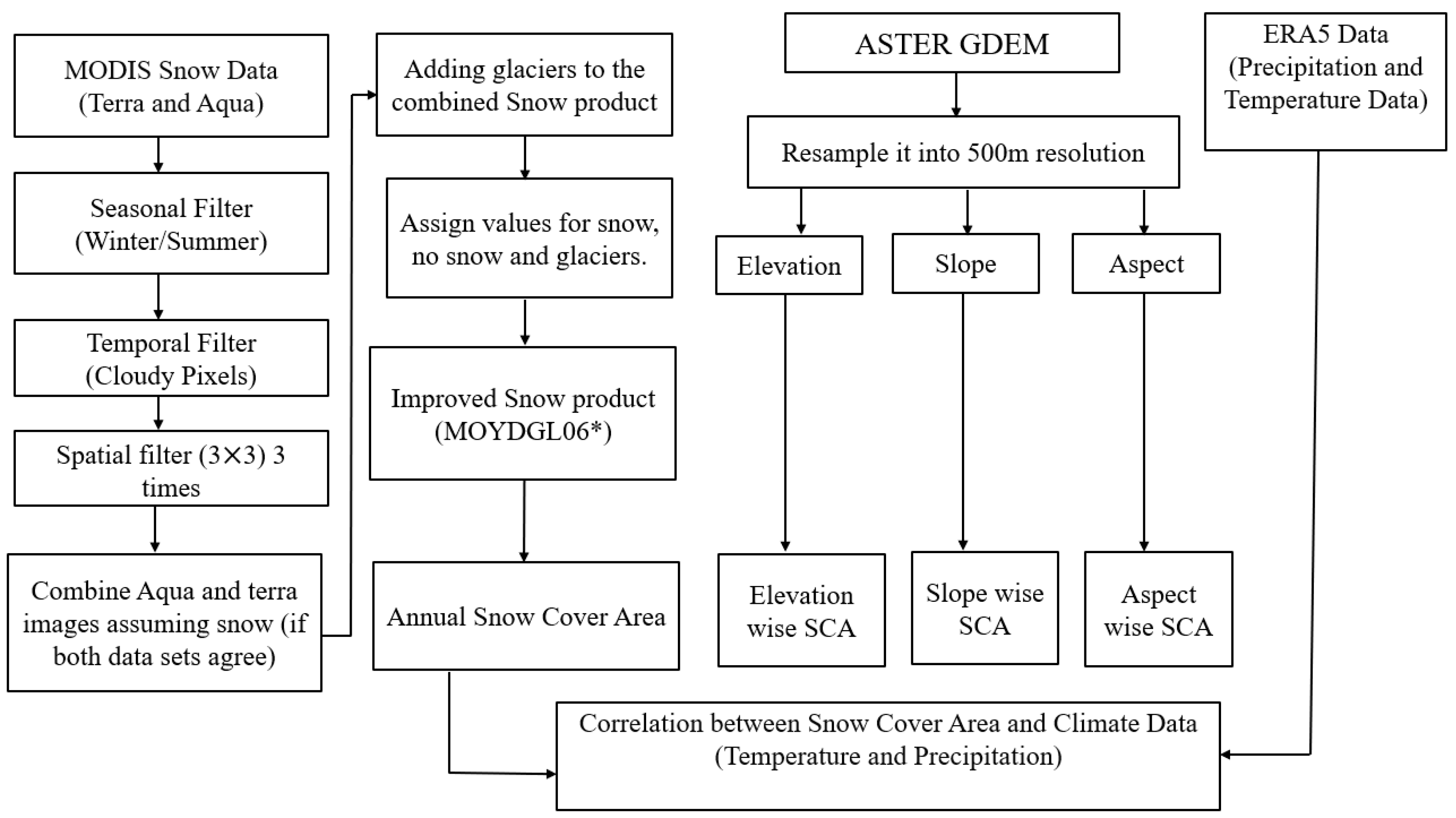



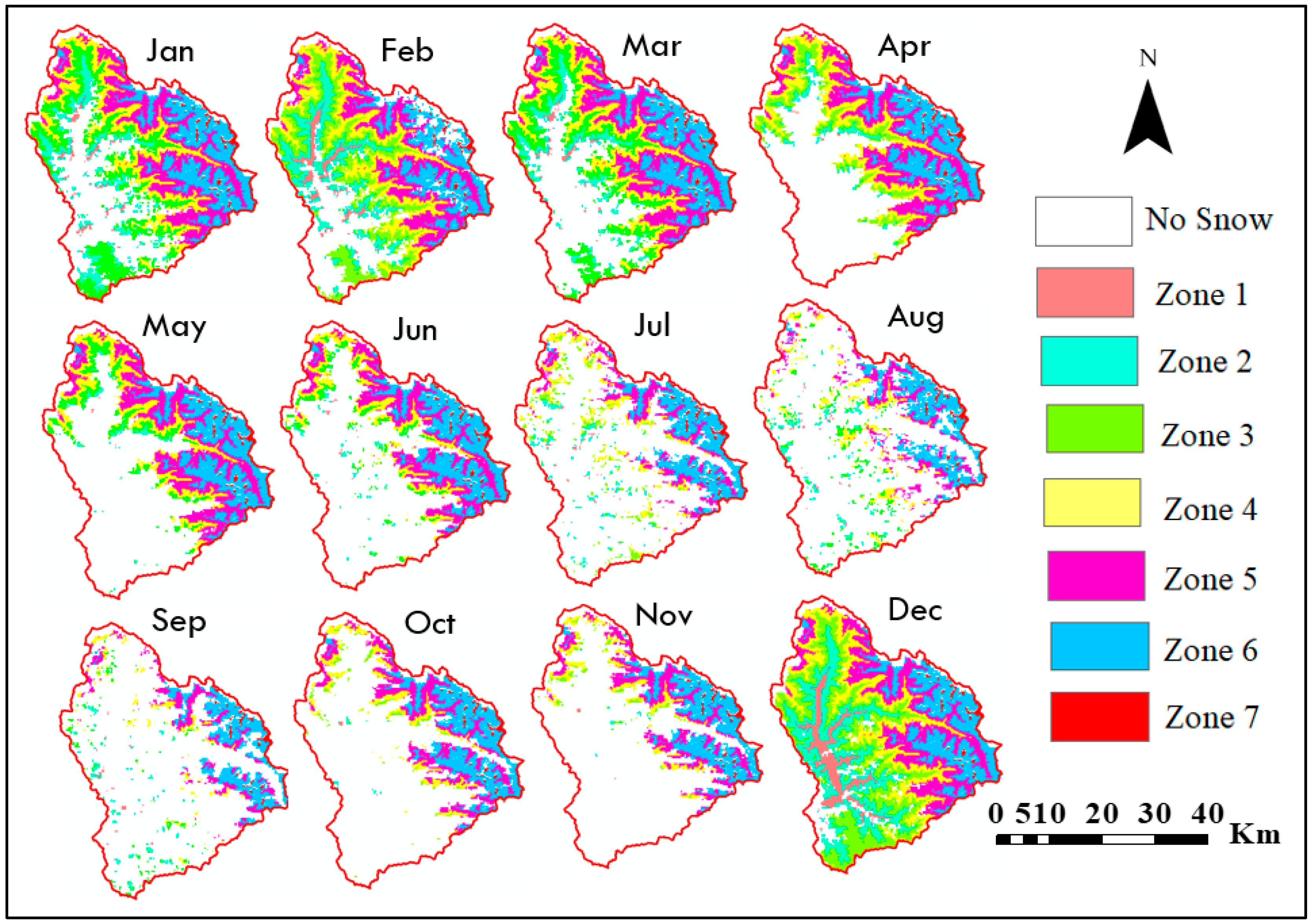


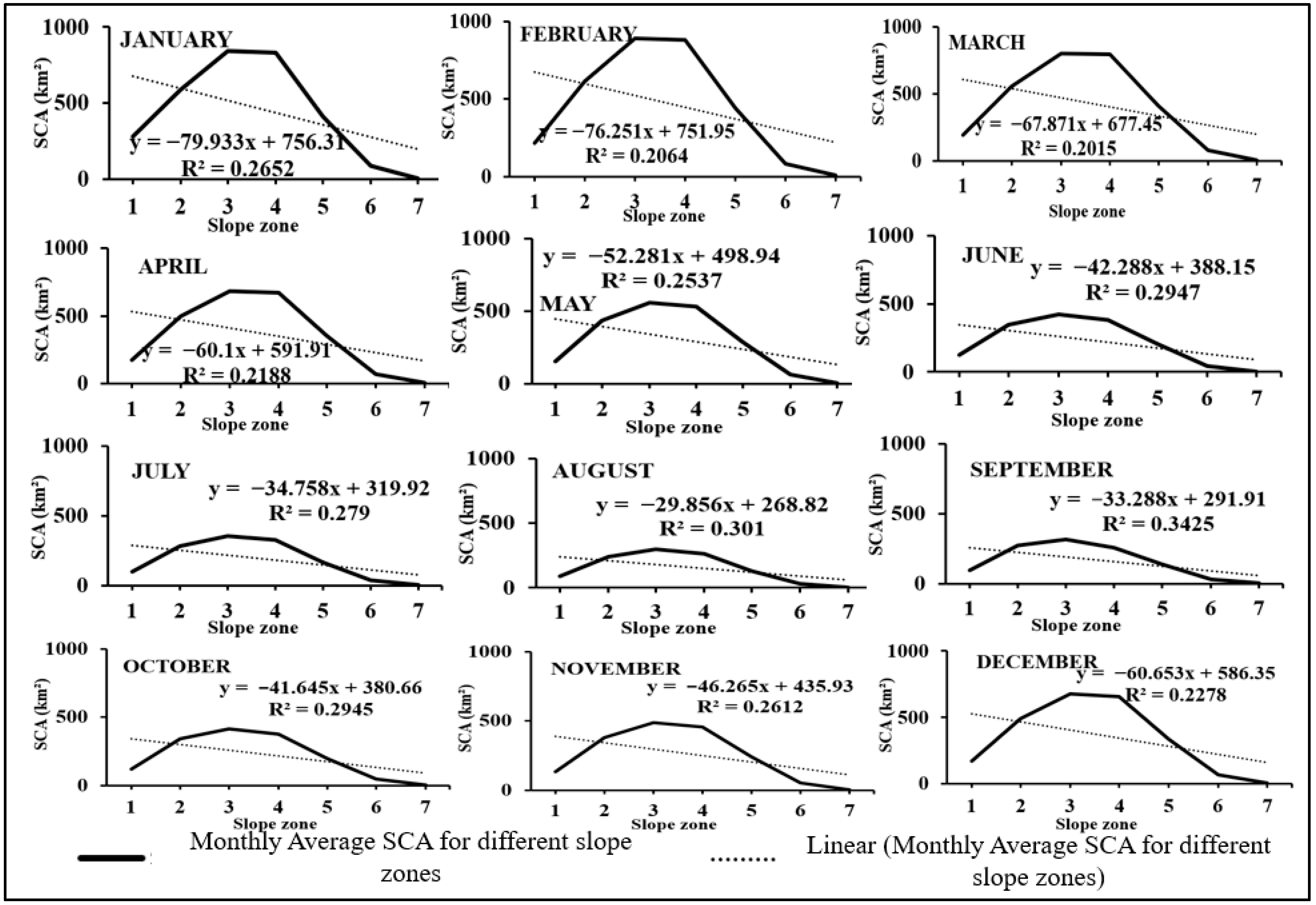

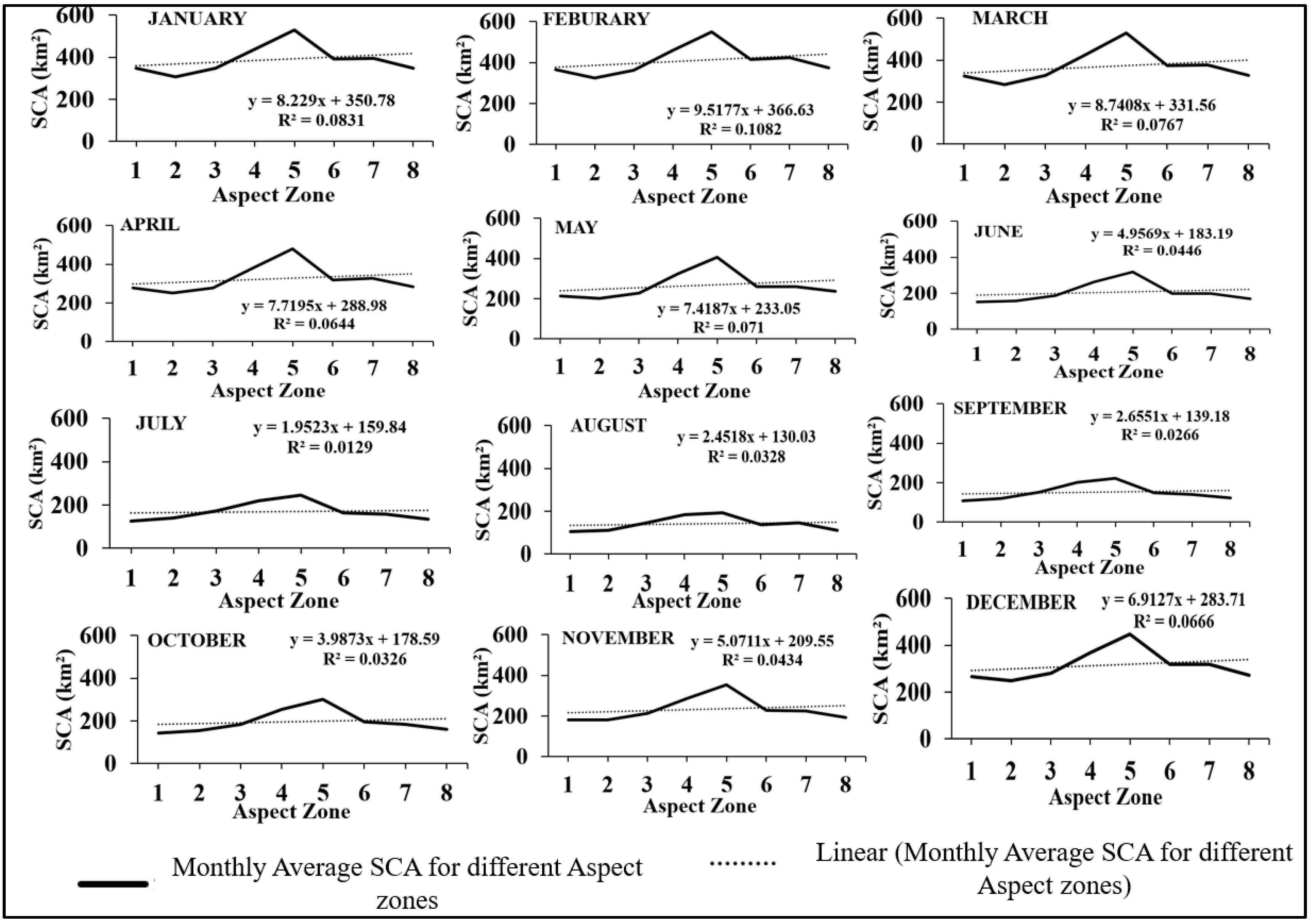
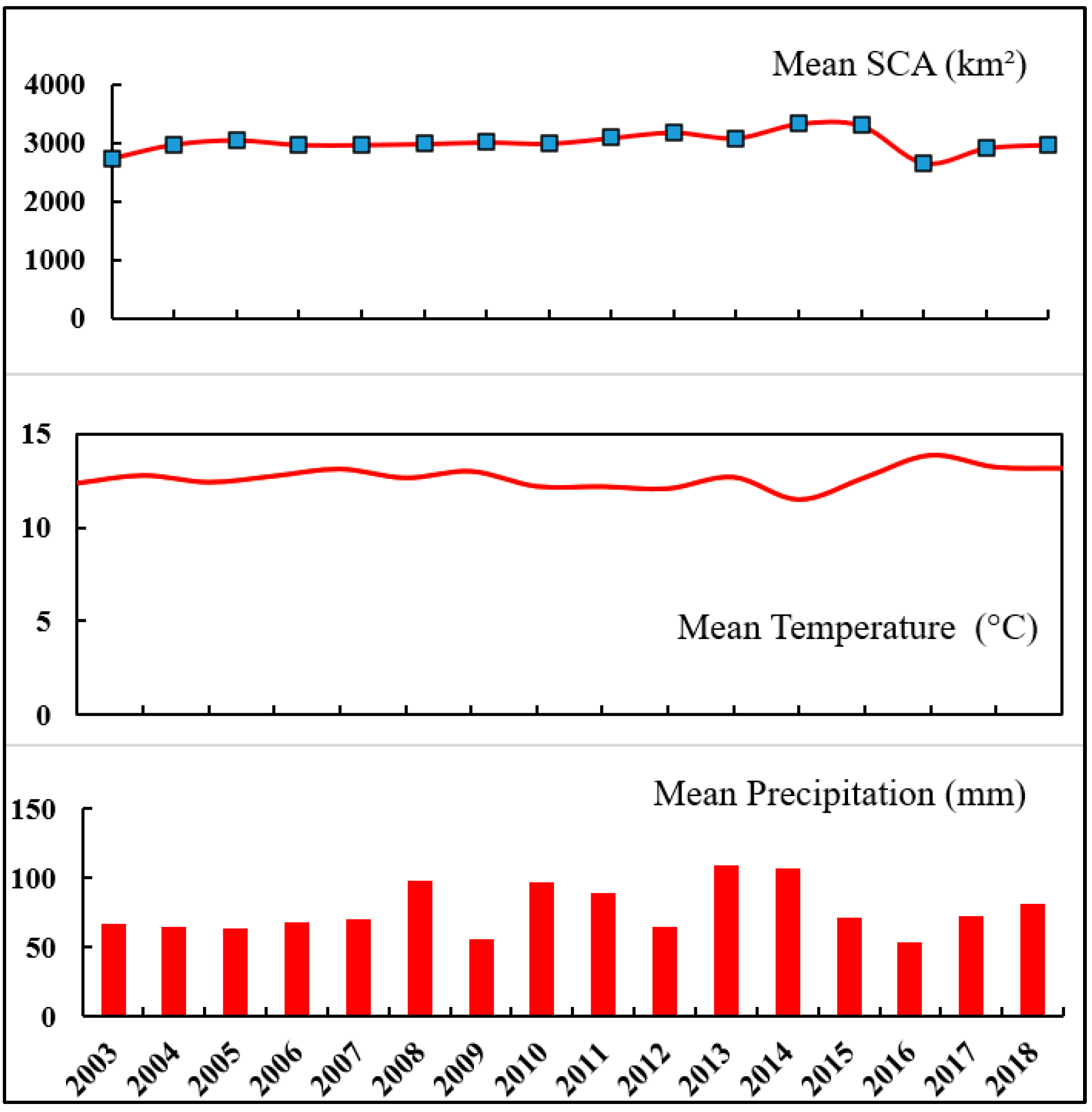

| (a) | ||
| Zone of Elevation | Elevation Range (m) | Area of Zone (km2) (%) |
| 1 | 853–1618 | 414.21 (7.69%) |
| 2 | 1618–2383 | 1149.10 (24.34%) |
| 3 | 2383–3148 | 1219.34 (22.64%) |
| 4 | 3148–3912 | 908.54 (16.87%) |
| 5 | 3912–4677 | 1107.57 (20.57%) |
| 6 | 4677–5442 | 571.47 (10.64%) |
| 7 | 5442–6582 | 13.46 (0.25%) |
| Total | 5384 (100%) | |
| (b) | ||
| Zone of Slope | Slope Range (°) | Area of Zone (km2) (%) |
| 1 | 00–10 | 506.23 (9.40%) |
| 2 | 10–20 | 1192.25 (22.14%) |
| 3 | 20–30 | 1944.85 (36.15%) |
| 4 | 30–40 | 1269.96 (23.58%) |
| 5 | 40–50 | 414 (7.69%) |
| 6 | 50–60 | 53.86 (1%) |
| 7 | 60–80 | 2.32 (0.04%) |
| Total | 5384 (100%) | |
| (c) | ||
| Zone of Aspect | Aspect | Area of Zone (km2) (%) |
| 1 | N | 688.19 (12.78%) |
| 2 | NE | 604.27 (11.22%) |
| 3 | E | 610.31 (11.33%) |
| 4 | SE | 670.31 (12.45%) |
| 5 | S | 726.12 (13.48%) |
| 6 | SW | 692.21 (12.85%) |
| 7 | W | 705.84 (13.14%) |
| 8 | NW | 686.45 (12.75%) |
| Total | 5384 (100%) | |
| Month | 2003 | 2004 | 2005 | 2006 | 2007 | 2008 | 2009 | 2010 | 2011 | 2012 | 2013 | 2014 | 2015 | 2016 | 2017 | 2018 | Average |
|---|---|---|---|---|---|---|---|---|---|---|---|---|---|---|---|---|---|
| January | 49.39 | 85.3 | 87.74 | 77.97 | 72.97 | 77.46 | 74.52 | 73.01 | 93.98 | 87.24 | 82.85 | 89.71 | 95.56 | 76.26 | 85.38 | 69.49 | 79.93 |
| February | 88.8 | 87.69 | 92.8 | 72.94 | 85.12 | 93.03 | 74.88 | 86.19 | 71.1 | 87.78 | 93.5 | 86.93 | 93.75 | 82.89 | 78.71 | 75.09 | 84.45 |
| March | 78.6 | 68.12 | 85.63 | 78.74 | 91.01 | 75.77 | 68.78 | 73.7 | 84.09 | 81.76 | 83.02 | 85.82 | 75.47 | 76.64 | 79.72 | 72.85 | 78.73 |
| April | 71.63 | 65.96 | 72.04 | 65.89 | 69.61 | 69.21 | 67.53 | 59.92 | 74.52 | 66 | 67.5 | 78.45 | 75.81 | 64.22 | 64.99 | 65.32 | 68.66 |
| May | 52.65 | 50.31 | 61.45 | 51.05 | 52.92 | 56.44 | 57.04 | 52.36 | 61.63 | 62.03 | 60.08 | 67.59 | 62.72 | 51.18 | 52.86 | 55.32 | 56.73 |
| June | 34.85 | 37.45 | 53.45 | 36.43 | 38.7 | 39.49 | 46.67 | 48.37 | 50.37 | 45.2 | 48.47 | 54.37 | 50.99 | 38.35 | 44.86 | 36.07 | 44.06 |
| July | 26.4 | 26.75 | 46.74 | 36.37 | 30.66 | 33.47 | 35.52 | 34.84 | 41.04 | 40.22 | 36.6 | 47.81 | 39.58 | 39.71 | 34.73 | 34.84 | 36.58 |
| August | 29.73 | 22.95 | 35.11 | 29.1 | 32.94 | 32.13 | 32.87 | 38.42 | 38.52 | 33.92 | 26.42 | 30.22 | 30.07 | 23.29 | 21.98 | 24.97 | 30.165 |
| September | 28.52 | 31.15 | 32.07 | 32.25 | 29.77 | 44.94 | 44.87 | 33.97 | 30.26 | 37.6 | 27.64 | 30.24 | 31.69 | 31.84 | 27.05 | 33.54 | 32.96 |
| October | 28.34 | 67.35 | 36.72 | 44 | 47.05 | 50.8 | 38.27 | 50.03 | 38.64 | 42.05 | 36.26 | 44.4 | 44.52 | 25.08 | 38.03 | 49.73 | 42.58 |
| November | 45.32 | 54.58 | 36.1 | 56.69 | 40.4 | 51.71 | 63.5 | 55.65 | 42.68 | 49.36 | 58.06 | 44.95 | 60.98 | 22.38 | 50.55 | 73.66 | 50.41 |
| December | 74.53 | 64.87 | 39.49 | 79.59 | 73.25 | 59.98 | 66.52 | 59.51 | 60.86 | 75.66 | 66.9 | 81.6 | 74.18 | 58.85 | 69.12 | 70.97 | 67.24 |
| Annual SCA (%) | 50.73 | 55.21 | 56.61 | 55.08 | 55.38 | 57.04 | 55.91 | 55.50 | 57.31 | 59.07 | 57.27 | 61.84 | 61.28 | 49.22 | 53.99 | 55.15 | 56.04 |
| Annual SCA (km²) | 2731 | 2973 | 3048 | 2966 | 2981 | 3071 | 3010 | 2988 | 3086 | 3180 | 3083 | 3329 | 3299 | 2650 | 2907 | 2969 | 3017 |
| Elevation Zone | Elevation Range (m) | Mid Elevation (m) | SCA (Min) (km2) | SCA (Max) (km2) | Average SCA (km2) |
|---|---|---|---|---|---|
| 1 | 853–1618 | 1235.5 | 2.35 | 38.46 | 119.88 |
| 2 | 1618–2383 | 2000.5 | 13.77 | 312.31 | 224.69 |
| 3 | 2383–3148 | 2765.5 | 57.88 | 592.32 | 553.95 |
| 4 | 3148–3912 | 3530 | 135.96 | 606.11 | 569.41 |
| 5 | 3912–4677 | 4294.5 | 290.03 | 872.34 | 916.28 |
| 6 | 4677–5442 | 5059.5 | 434.34 | 589.29 | 560.67 |
| 7 | 5442–6582 | 6012 | 59.29 | 78.89 | 72.42 |
| Total | 3017.3 km2 (56.03%) |
| Slope Zone | SCA (Min) (km2) | SCA (Max) (km2) | Average SCA (km2) |
|---|---|---|---|
| 1 | 85.72 | 278.51 | 234.09 |
| 2 | 240.13 | 713.76 | 657.23 |
| 3 | 294.2 | 889.03 | 861.26 |
| 4 | 263.96 | 898.99 | 835.73 |
| 5 | 130.78 | 490.05 | 375.96 |
| 6 | 28 | 54.9 | 50.91 |
| 7 | 2.96 | 3.82 | 2.12 |
| 3017.3 km2 (56.03%) |
| Aspect Zone | SCA (Min) (km2) | SCA (Max) (km2) | Average SCA (km2) |
|---|---|---|---|
| 1 | 271.29 | 349.13 | 304.29 |
| 2 | 269.85 | 305.96 | 235.05 |
| 3 | 302.12 | 368.63 | 349.59 |
| 4 | 376.67 | 447.83 | 427.12 |
| 5 | 441.16 | 627.45 | 595.19 |
| 6 | 305.65 | 399.80 | 376.12 |
| 7 | 315.76 | 401.41 | 394.99 |
| 8 | 178.62 | 373.74 | 334.95 |
| 3017.3 km2 (56.03%) |
| Season | Precipitation Z | Q (°C/Year) | Trend (95%) | Temperature Z | Q (°C/Year) | Trend (95%) |
|---|---|---|---|---|---|---|
| Winter | −1.10 * | −0.965 | Falling | 0.00 | 0.063 | No Trend |
| Pre-monsoon | 0.267 * | 1.746 | Rising | 0.033 * | 0.050 | Rising |
| Monsoon | 0.167 * | 1.313 | Rising | 0.517 * | 0.066 | Risings |
| Post-monsoon | 0.183 * | 0.341 | Rising | 0.150 * | 0.048 | Rising |
| Annual | 0.233 * | 1.892 | Rising | 0.117 * | 0.029 | Rising |
Disclaimer/Publisher’s Note: The statements, opinions and data contained in all publications are solely those of the individual author(s) and contributor(s) and not of MDPI and/or the editor(s). MDPI and/or the editor(s) disclaim responsibility for any injury to people or property resulting from any ideas, methods, instructions or products referred to in the content. |
© 2023 by the authors. Licensee MDPI, Basel, Switzerland. This article is an open access article distributed under the terms and conditions of the Creative Commons Attribution (CC BY) license (https://creativecommons.org/licenses/by/4.0/).
Share and Cite
Sunita; Gupta, P.K.; Petropoulos, G.P.; Gusain, H.S.; Sood, V.; Gupta, D.K.; Singh, S.; Singh, A.K. Snow Cover Response to Climatological Factors at the Beas River Basin of W. Himalayas from MODIS and ERA5 Datasets. Sensors 2023, 23, 8387. https://doi.org/10.3390/s23208387
Sunita, Gupta PK, Petropoulos GP, Gusain HS, Sood V, Gupta DK, Singh S, Singh AK. Snow Cover Response to Climatological Factors at the Beas River Basin of W. Himalayas from MODIS and ERA5 Datasets. Sensors. 2023; 23(20):8387. https://doi.org/10.3390/s23208387
Chicago/Turabian StyleSunita, Pardeep Kumar Gupta, George P. Petropoulos, Hemendra Singh Gusain, Vishakha Sood, Dileep Kumar Gupta, Sartajvir Singh, and Abhay Kumar Singh. 2023. "Snow Cover Response to Climatological Factors at the Beas River Basin of W. Himalayas from MODIS and ERA5 Datasets" Sensors 23, no. 20: 8387. https://doi.org/10.3390/s23208387









